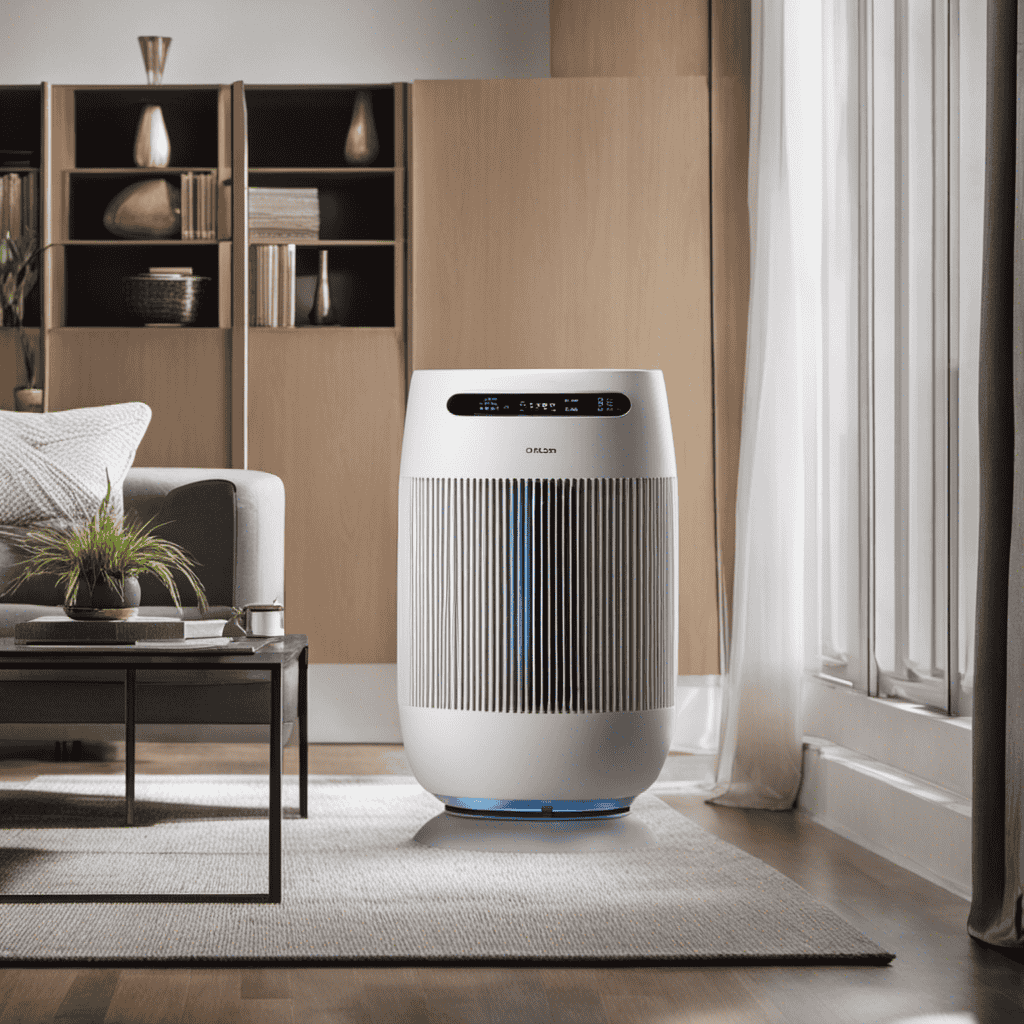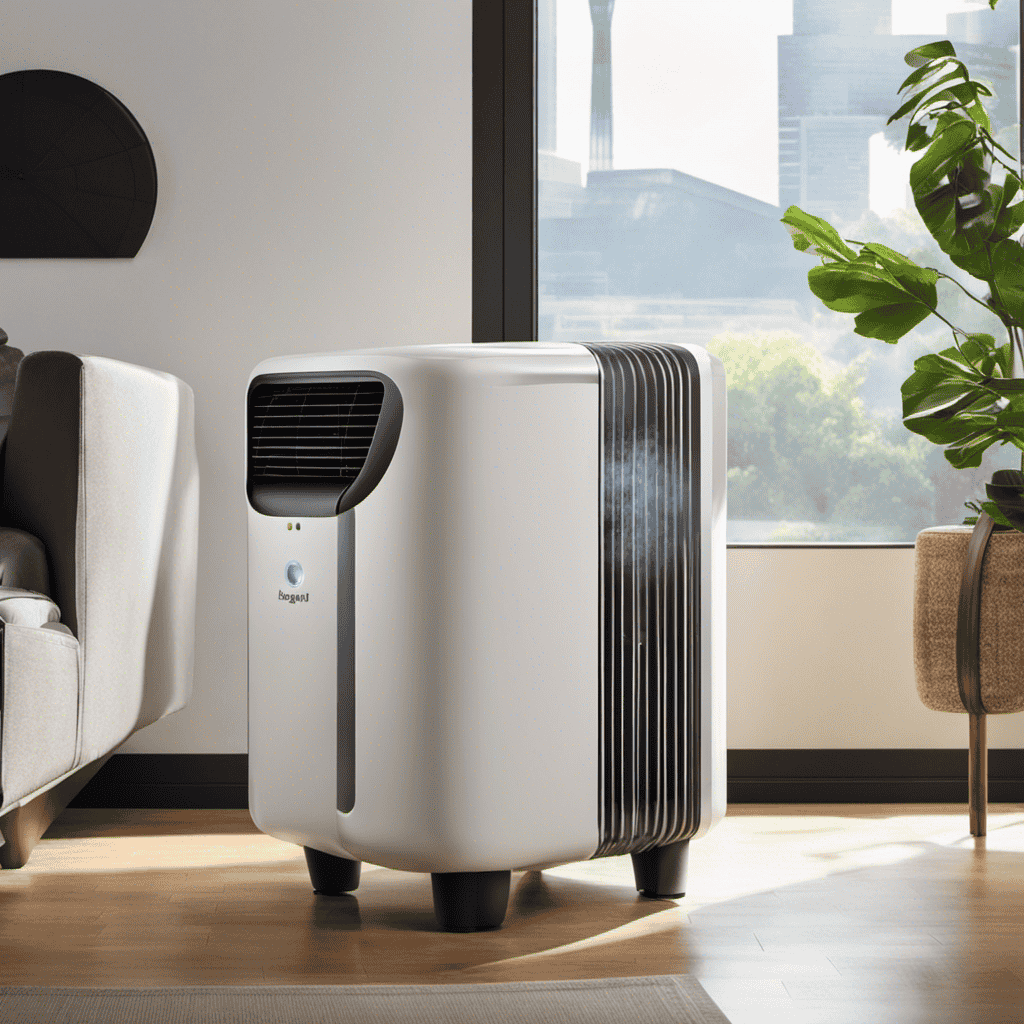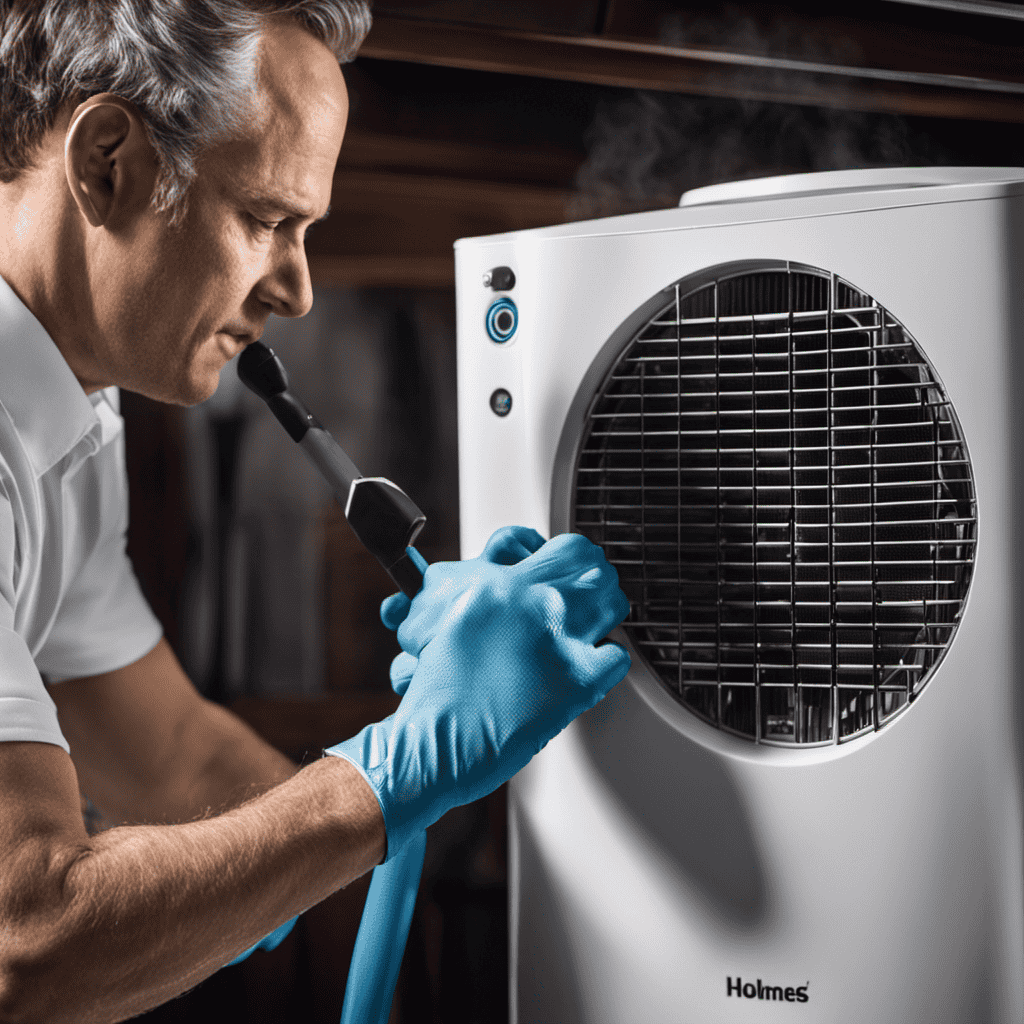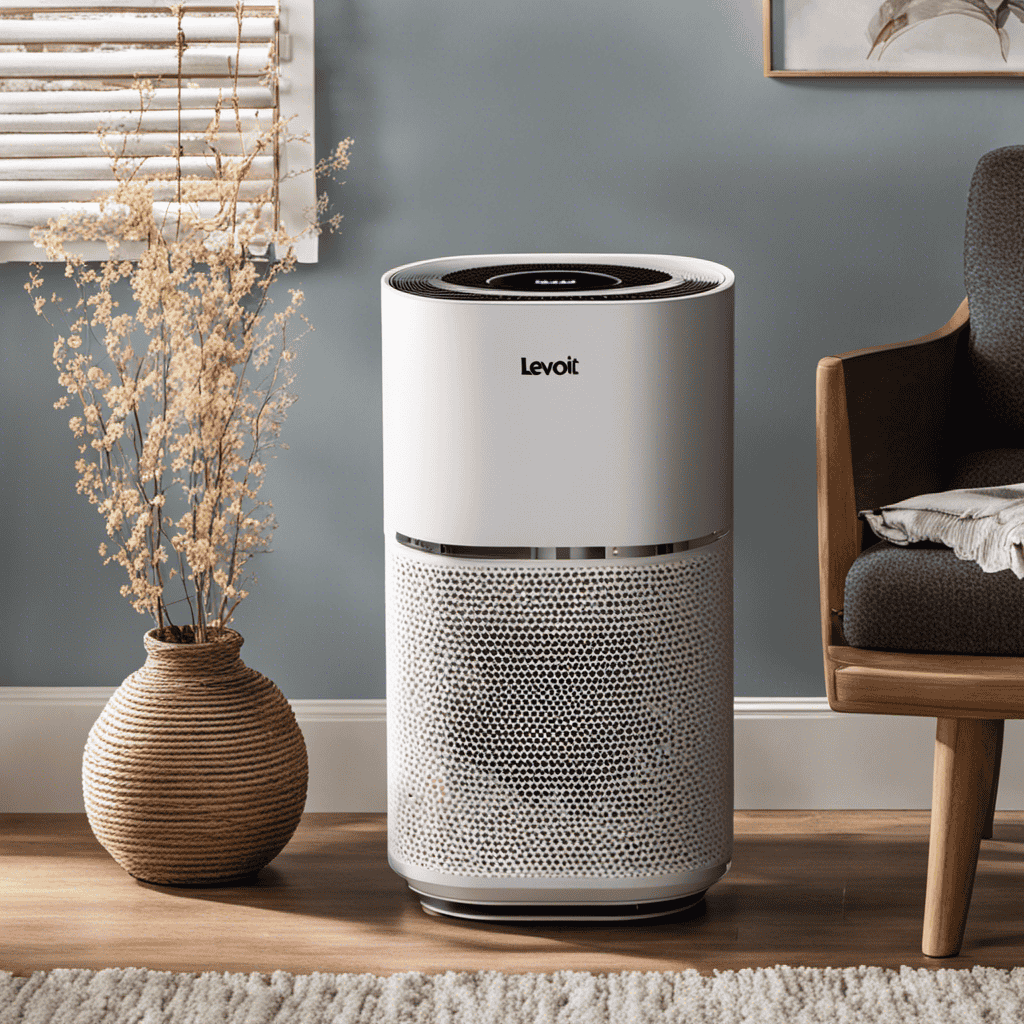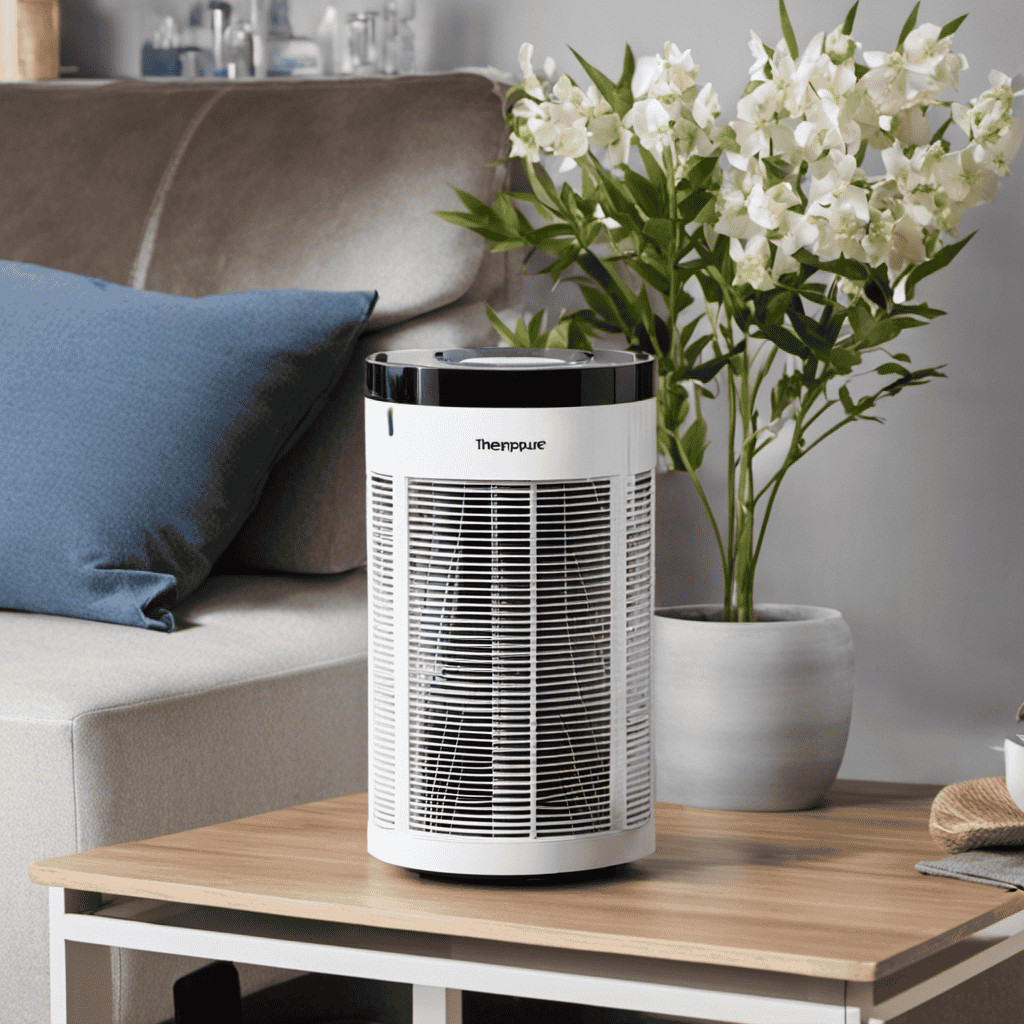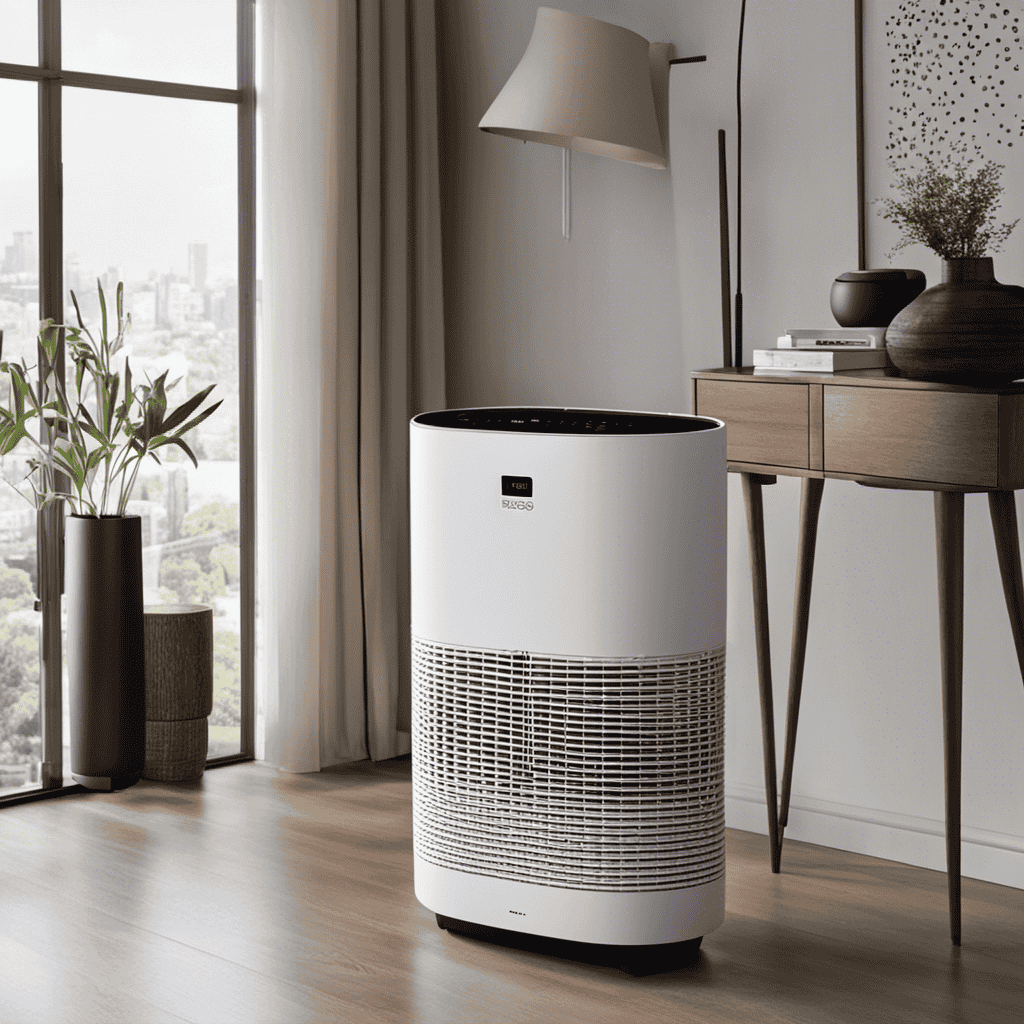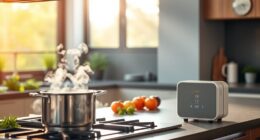Inhaling the fresh, purified air, I find myself in awe of the marvels that modern innovation has brought into our lives. Air purifiers, for instance, have turned into a crucial component of my daily routine, owing to the remarkable capabilities they provide.
One such function that captures my attention is the ioniser. But what does an ioniser actually do on an air purifier? In this article, I will delve into the depths of this fascinating feature, explaining its purpose and shedding light on its impact on indoor air quality.
So, join me on this journey as we uncover the secrets behind the ionisation process and discover the benefits it brings to our well-being.
Key Takeaways
- Ionisers emit negative ions into the air, which attach to positively charged particles and make them heavier, causing them to fall to the ground or stick to surfaces.
- The use of ionisers in air purifiers can remove pollutants, allergens, and pathogens from the air, reducing the risk of allergies, respiratory issues, and promoting better air quality and respiratory health.
- Negative ions produced by ionisers have positive effects on well-being, such as increasing oxygen flow to the brain and improving mood.
- Regular maintenance of ionisers, including cleaning the ionising plates, is essential to ensure optimal performance, prolong the lifespan of the air purifier, and reduce the risk of potential health hazards.
The Function of Ionisers in Air Purifiers
The ioniser in an air purifier helps to remove airborne particles and allergens from the air you breathe. It does this by emitting negative ions into the air, which attach themselves to positively charged particles like dust, pollen, and pet dander. This causes the particles to become heavy and fall to the ground or stick to surfaces, effectively removing them from the air you breathe.
However, it is important to note that ionisers have some negative effects. They can produce ozone as a byproduct, which can be harmful when inhaled in high concentrations. Additionally, ionisers may not be as effective in larger spaces or in environments with high levels of pollutants.
As an alternative, there are other technologies for air purification such as HEPA filters, activated carbon filters, and UV germicidal lamps, which can effectively remove airborne particles without producing ozone or other potentially harmful byproducts.
How Ionisers Improve Indoor Air Quality
One way ionisers help improve indoor air quality is by releasing negatively charged ions that attract and neutralise airborne particles. These negatively charged ions are attracted to positively charged airborne contaminants, such as dust, pollen, and bacteria, causing them to become heavy and fall out of the air.
This process, known as ionisation, helps to reduce the number of harmful particles in the air, making it cleaner and healthier to breathe. Additionally, negative ions have been found to have a positive effect on our well-being. They can increase the flow of oxygen to the brain, improve mood, and even enhance sleep quality.
Understanding the Ionisation Process in Air Purifiers
When it comes to air quality, ionisation plays a crucial role. Ionisers are devices that release negatively charged ions into the air, which attach themselves to pollutants, such as dust, pollen, and smoke particles.
The benefits of ionisers include improved air quality, reduction in allergens, and elimination of odors. These devices work by creating an electrical charge that causes the ions to attach to pollutants, making them heavier and causing them to fall out of the air, resulting in cleaner and fresher indoor environments.
Ionisation and Air Quality
To improve the air quality in your home, an ioniser on your air purifier helps to remove pollutants and allergens. Here are three ways in which ionisation can benefit your respiratory health:
-
Ionisation neutralizes harmful particles: An ioniser emits negatively charged ions that attach to positively charged particles in the air, such as dust, pollen, and pet dander. This causes the particles to become heavy and fall to the ground, preventing them from being inhaled and reducing the risk of triggering allergies or respiratory issues.
-
Ionisation reduces airborne pathogens: Ionisers have been shown to effectively deactivate certain viruses, bacteria, and mold spores in the air. By neutralizing these pathogens, ionisers can help prevent the spread of respiratory illnesses and improve overall air quality.
-
Ionisation promotes relaxation and well-being: Negative ions produced by ionisers have been linked to increased serotonin levels in the brain, which can enhance mood and reduce stress. This can have a positive impact on respiratory health, as stress and anxiety can exacerbate respiratory conditions.
With these benefits in mind, it is clear that ionisers play a crucial role in improving air quality and maintaining respiratory health in your home.
Benefits of Ionisers
The benefits of ionisers include removing pollutants and allergens from the air, reducing the risk of allergies and respiratory issues, deactivating pathogens, and promoting relaxation and well-being.
Ionisers work by releasing negatively charged ions into the air. These ions attach themselves to airborne particles, such as dust, pollen, and pet dander, causing them to become heavy and fall to the ground or stick to surfaces. This process effectively removes these pollutants from the air, resulting in improved breathing and reduced allergies.
Additionally, ionisers can help deactivate pathogens, such as bacteria and viruses, by disrupting their cellular structure. This can further enhance air quality and reduce the risk of respiratory infections.
Furthermore, the release of negative ions can also have a calming effect on the body, promoting relaxation and overall well-being.
How Ionisers Work
You can understand how ionisers work by thinking of them as devices that release negatively charged ions into the air. These ions attach to particles in the air, such as dust, pollen, and pet dander, causing them to become heavier and fall to the ground.
This process, known as ionisation, helps to remove these allergens from the air, reducing the risk of allergies and improving respiratory health.
-
Ionisation: Ionisers use an electrical charge to produce negatively charged ions, which are then released into the air. These ions attach to airborne particles, making them too heavy to remain suspended in the air.
-
Allergen removal: By effectively removing allergens from the air, ionisers can help alleviate symptoms of allergies such as sneezing, coughing, and itchy eyes.
-
Respiratory health: Breathing in clean, ionised air can have a positive impact on respiratory health. Removing airborne pollutants can reduce the risk of respiratory illnesses and improve overall lung function.
Benefits of Using an Air Purifier With an Ioniser
Using an air purifier with an ioniser can greatly improve the quality of the air you breathe. Ionisers are advantageous features in air purifiers as they help to remove harmful particles from the air.
The ioniser emits negatively charged ions that attach to the positively charged particles in the air, such as dust, pollen, and pet dander. This process causes the particles to become heavier and fall to the ground or onto surfaces, making it easier to clean them up.
Additionally, ionisers can also reduce the presence of airborne bacteria and viruses, promoting a healthier living environment. However, it is important to note that there are potential drawbacks of using ionisers in air purifiers, which will be discussed in the subsequent section.
Potential Drawbacks of Ionisers in Air Purifiers
When considering ionisers in air purifiers, it’s important to be aware of their potential drawbacks. While ionisers can be effective in removing pollutants from the air, there are a few potential risks and health concerns to consider:
-
Ozone production: Ionisers generate ozone as a byproduct, which can be harmful to the respiratory system when present in high levels. Individuals with respiratory conditions such as asthma may experience worsened symptoms.
-
Limited effectiveness: Ionisers primarily work by charging particles in the air, causing them to stick to surfaces. However, this means that the particles are not completely removed from the air. They can easily be stirred up again, reducing the long-term effectiveness of the purifier.
-
Maintenance requirements: Ionisers require regular cleaning to prevent the buildup of charged particles on surfaces. Failure to clean the purifier can lead to decreased performance and potential health risks.
Considering these potential drawbacks, it is essential to take certain steps to maximize the effectiveness of ionisers in air purifiers.
Tips for Maximizing the Effectiveness of Ionisers in Air Purifiers
To make sure ionisers are as effective as possible, it’s important to regularly clean them to prevent the buildup of charged particles. Cleaning an ioniser is a simple process that can greatly enhance its performance.
One common misconception about ionisers is that they do not require regular cleaning. However, over time, dust and debris can accumulate on the ionising plates, reducing their efficiency.
To clean an ioniser, first, turn off the device and unplug it from the power source. Then, gently wipe the ionising plates with a soft cloth or brush to remove any dirt or dust. It’s important to avoid using water or liquid cleaners, as they can damage the electrical components.
Additionally, some ionisers have removable plates that can be soaked in warm soapy water for a more thorough cleaning.
Frequently Asked Questions
Is It Safe to Use an Air Purifier With an Ioniser in a Household With Pets?
Yes, it is safe to use an air purifier with an ioniser in a household with pets. The ioniser helps to remove pet dander and other allergens from the air, improving the air quality and reducing allergies.
Can Ionisers Remove Unpleasant Odors From the Air?
Ionisers on air purifiers improve indoor air quality by removing harmful particles, including odors. They release negatively charged ions that attach to pollutants, causing them to fall out of the air.
Do Ionisers Produce Ozone, and Is It Harmful to Breathe In?
Ionisers on air purifiers release negatively charged ions that attach to airborne particles, causing them to fall to the ground. This can effectively reduce indoor pollution. However, some ionisers may also produce ozone, which can be harmful to breathe in.
How Often Should the Ioniser Plates Be Cleaned or Replaced?
Cleaning the ioniser plates effectively is crucial for maintaining the benefits of using an ioniser in an air purifier. Regular cleaning, according to the manufacturer’s instructions, ensures optimal performance and removes accumulated contaminants.
Can Ionisers Help Alleviate Symptoms of Allergies or Asthma?
Ionisers on air purifiers can help alleviate symptoms of allergies or asthma. They release negatively charged ions that attach to airborne particles, causing them to become heavy and fall to the ground. However, their effectiveness can vary depending on the environment.
Conclusion
In conclusion, the ioniser in an air purifier plays a crucial role in improving indoor air quality. By releasing negatively charged ions into the air, it helps to neutralize and remove harmful pollutants such as dust, pollen, and allergens.
Research shows that ionisers can effectively reduce airborne particles by up to 99%. This statistic highlights the significant impact that ionisers can have on creating a healthier and cleaner environment for individuals, particularly those who suffer from respiratory conditions or allergies.
Therefore, investing in an air purifier with an ioniser can be a wise choice for anyone concerned about their indoor air quality.
